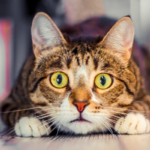Unexpected allergies
If we surveyed pet owners about potential allergy symptoms in dogs and cats, most would list signs such as recurrent ear infections, generalised itchiness, paw licking, or tummy upset. But did you know that allergies can also cause problems with your pet’s eyes, mouth, lungs, or bottom?
Here are some lesser-known allergy issues to watch for in dogs and cats.
1. Allergic conjunctivitis
Conjunctivitis involves inflammation of the conjunctiva, the pink tissue that lines the inner eyelids and covers the eyeball.
Airborne particles such as pollen can trigger allergic conjunctivitis in pets. As a result, they develop eye redness, abnormal eye discharge (which may be watery or cloudy and yellow-green), squinting, and sometimes itchiness around the eyes or face.
Vets commonly treat allergic conjunctivitis with steroid eye medications and saline cleaning. However, some cases may also require antibacterial medicines for secondary bacterial infection. Before prescribing eye medication, the vet may need to perform a fluorescein test, where dye is dripped into the affected eye/s to check for any scratches or ulcers on the surface.
2. Feline asthma
Feline asthma is a chronic (long-term) condition that causes inflammation and narrowing of the airways within the lungs, leading to breathing difficulties and symptoms such as recurrent coughing, wheezing, or increased breathing effort.
Cats with asthma can rapidly worsen if exposed to a particular allergic trigger (such as dust or cigarette smoke) or a stressful event. They may require emergency oxygen therapy and medications to relieve their airway spasms and swelling.
Long-term management of cats with asthma relies on steroids to settle airway irritation. Cooperative cats may be switched from oral medication to a steroid puffer in the long term for ongoing maintenance with fewer adverse side effects.
3. Feline rodent ulcers
Feline rodent (indolent) ulcers are inflammatory lesions in some cats due to underlying allergies or parasitic infections.
They usually appear on the margin of the upper lip as a firm, raised lesion with an ulcerated surface. The cat’s lip is often swollen in this area, sometimes significantly. Cats affected by this condition may also develop other lesions in their mouth or elsewhere on their body.
Cats with rodent ulcers require investigation and treatment for underlying allergic or parasitic conditions, including rigorous flea control, anti-inflammatory medicine and sometimes a hypoallergenic diet.
4. Bottom scooting
The most common causes of recurrent bottom scooting in dogs are intestinal worms, allergies, or anal gland problems.
If your pet shows frequent bottom-dragging behaviours, your vet will confirm their parasite control routines, check their anal glands for any signs of blockage or infection, and assess them for other symptoms of allergies.
Depending on your pet’s underlying trigger, treatment may consist of flea control, deworming, anal gland emptying or flushing, or long-term management of allergies with anti-itch medication.
So, if your pet demonstrates any of the above more unusual allergy symptoms, hurry into our clinic so our experienced vets can get to the bottom of your pet’s issue!






